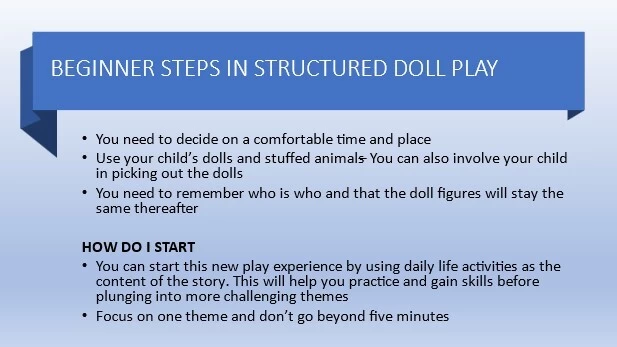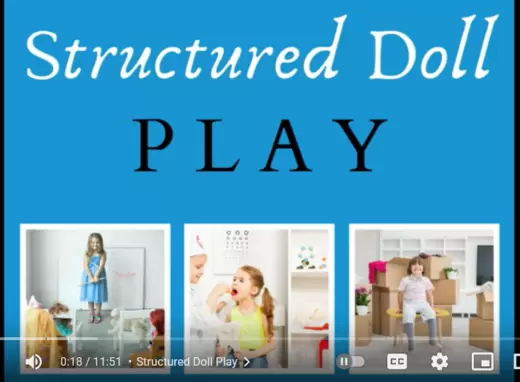WHAT IS STRUCTURED DOLL PLAY?
Structured doll play is a lively way of storytelling for parents to help children who are feeling anxious or insecure. It provides a brief and specific experience for the children to prepare them for anxiety-provoking experiences, such as parents’ divorce, going over to the babysitter, and so forth, or to help them regain a sense of normalcy and routine after a significant change in their life. It has a specific purpose and a clear message (e.g., Mum is going to come back at the end of the day to pick Lucy up).
CAN MY CHILD BENEFIT FROM STRUCTURED DOLL PLAY?
If your child is showing anxiety or fear, or has been through a traumatic experience, he/she can probably benefit from you using structured doll play with him/her. Structured doll play works best with children from ages 2–6. However, older or younger children can also benefit from it.
HOW DO I DO STRUCTURED DOLL PLAY?
Creating the Story
Structured doll play is basically creative storytelling about specific real life happenings. It is similar to reading a story from a storybook to your child; the major differences are:
- You create the story instead of reading out of a storybook.
- The story involves real life characters, such as Mum, Dad, Lucy (your child), babysitter Jane, Grandma, schoolteacher, dentist, and so forth.
- The story is about real life happenings, usually about future events that are coming up in the next day or two. It can also be a story of routine daily happenings.
- You have a specific purpose and a clear message. For example: Lucy is reluctant to go to the new day care. She would not let you leave when you dropped her off at day care. Your purpose is helping Lucy to feel more comfortable about going to day care. Your message may be, “Mum is going to return at the end of the day.” (It’s important that the message fit what the parent believes is of most concern to the child.)
- You use dolls to enhance the dramatic effect and help your child remember. You can also use sound effects to enrich the story and make it more powerful and fun. Remember, young children understand concrete things like dolls and scenes better than promises and reasons.
The making of a story (think about a beginning, middle, and an end)
Beginning Don’t start off by saying Lucy is going to the babysitter. Start off by giving some background for the story (e.g., a predictable routine, like waking up in the morning).
Middle Give content to the story by putting in details (e.g., putting on shoes or buckling seat belt). Remember to exaggerate and use sound effects (you’ll probably feel silly at first, but children love it!).
End Remember to end the story. Don’t leave your child hanging. End the story with a big kiss.
“Mum drives to the babysitter’s (Jane) house and rings the bell (ding- dong). Jane opens the door and Lucy sees Mum. Lucy jumps into Mum’s lap. Mum gives Lucy a big hug and a kiss (make kissing noise). Mum and Lucy drive home together. They talk about the day on the way home .”
- Start with a title sentence (e.g., “This is a story about Lucy going to the babysitter”).
- Introduce the characters by using real names of people.
- Tell the story (don’t use “you” for the doll representing your child. Use your child’s name to stay objective, e.g., “Lucy is saying goodbye to Mum” rather than “You are saying goodbye to Mum)

Props and place
Remember: This is a creative business. So you need to decide on a comfortable time and place to do structured doll play and prepare your props (dolls) ahead of time. A good time might be in your child’s bedroom in the evening before bedtime (to avoid disruptions and create a routine). You don’t need to buy any special dolls —use your child’s dolls and stuffed animals or puppets. (Save your money to give yourself a treat after telling a good story—it’s a lot of work to tell a really good story!) You can also
involve your child in picking out the dolls/stuffed animals by saying “I’ve got a special story to tell you tonight. It’s about a little girl name Lucy who goes to Jane’s (the babysitter). To tell the story, we need a Lucy doll, a mummy doll, a Daddy doll, and a Jane doll. Can you help me pick out a doll (stuffed animal) for each character? (Make sure you have a selection of your child’s dolls/stuffed animals lined up to choose from.) Note: You need to remember who is who, and the doll figures stay the same person thereafter (you can add new dolls as You use this method to tell different stories, like going to the dentist for the first time, etc.).
How do I start?
You can start this new play experience by using nonthreatening, general daily life activities as the content of the story (e.g., going to the grocery store). This will help you practice and gain skills before plunging into more challenging themes. Focus your story on one theme and don’t go beyond five minutes. You can think the story out in your head, or you can jot down brief notes to use as the script.
Helpful hints:
- It may seem awkward to tell stories and act them out. Be patient with yourself— YOUR CHILD WILL THINK IT’S FUN AND WON’T NOTICE IF YOU MESS UP!
- Include only those elements in the story that you have control over. Don’t say how much fun Lucy is going to have (she may not be having much fun, if she’s anxious). If you say something is going to happen at the babysitter’s (going to the park, etc.), make sure you ask that the babysitter follow through on that activity the next day. The entire point of the story is to help the child feel more secure by being able to predict what will happen.
- Don’t build on your own feelings when you are telling the story. For example, “Mum is working in the office while Lucy is playing in day care. Mum is thinking of Lucy and she misses Lucy.” Remember: The goal is to help Lucy go to day care without feeling anxious, so she can relax and have fun.
- Make the story realistic and positive. You are the author of the story, so you can make it the way you want it to turn out in real life. Instead of focusing the story on how Lucy doesn’t want to leave Mum, make the story go like this: “Lucy and Mum ring the doorbell together (ding-dong!). The door opens and Lucy smiles when she sees Jane. Lucy gives Mum a big hug, and she and Jane wave goodbye to Mum together….” (Remember to let Jane know about your story.)
- Always end the story on a positive note THAT YOU CAN CONTROL. If the story involves the child not seeing you for several hours (especially if that is part of the concern), always include an “I’m so glad to see you!” reunion with kisses and hugs. The graphic representation of using dolls is more powerful than a verbal promise.
- Your child may get distracted and interrupt the story. Briefly attend to the child, but be sure to finish the story. Telling the story after the child is already in bed helps with distractions. Parent can respond to requests to play with something else by saying, “You can play with your other dolls tomorrow; it’s bedtime now.” Or, if your child asks for a drink, “As soon as we’ve finished the story, I’ll get you a drink.”
